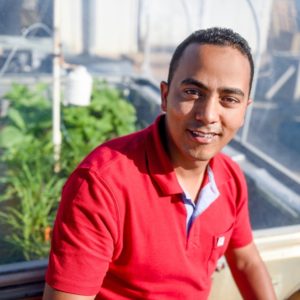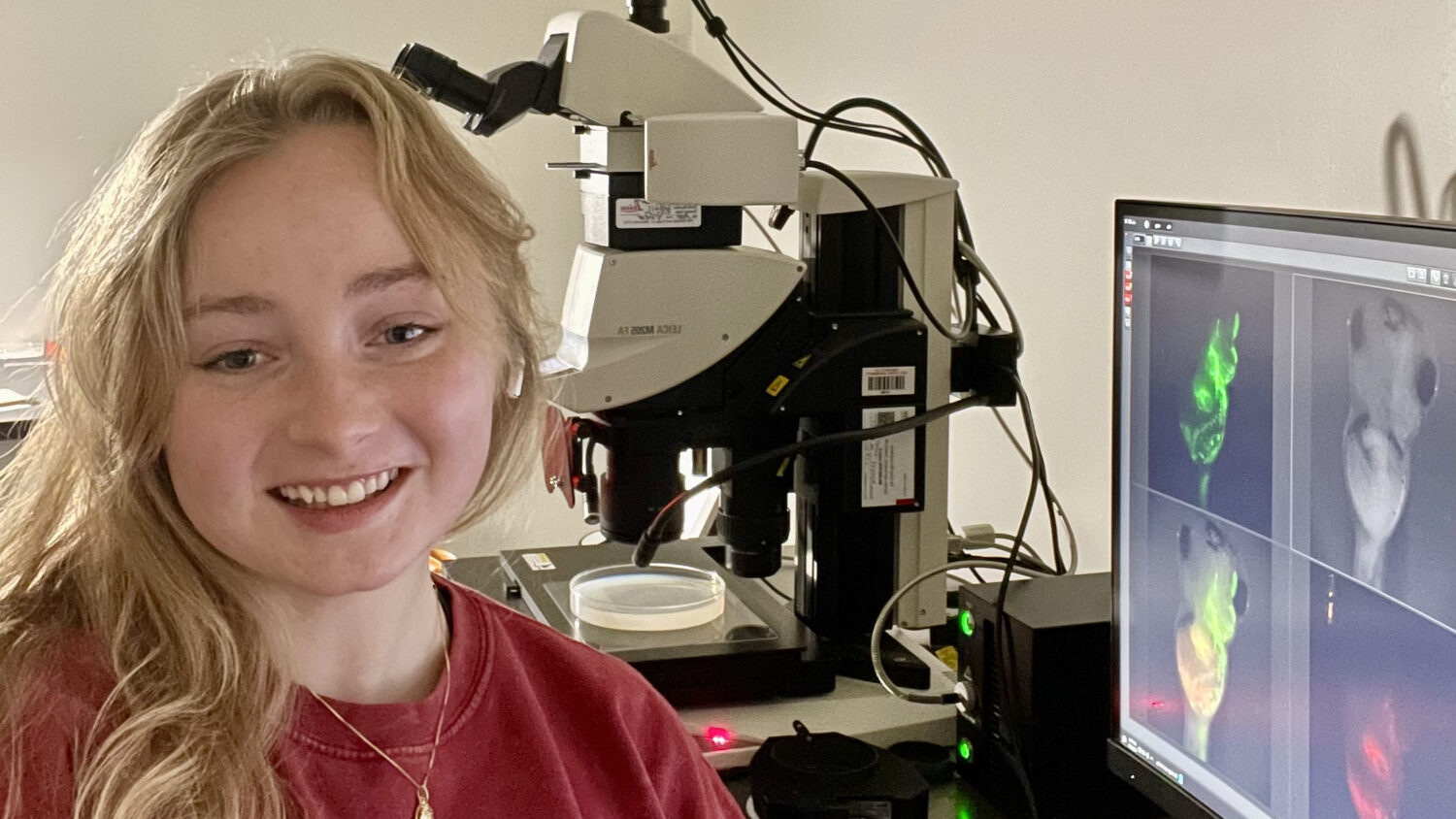Student’s Research Seeks Ozone-Tolerant Wheat

Sayed Mashaheet’s research into wheat and ozone tolerance could actually help prevent a worldwide famine. The NC State University Ph.D. student in entomology and plant pathology is working to develop resilient wheat varieties that are more tolerant to ozone — a pollutant often associated with climate change – as well as more resistant to wheat rust, a devastating disease that looks like rust on wheat stalks.
In 1998, a new strain of wheat rust was detected in Uganda. It was confirmed in 1999 and named Ug99. This new strain of the disease can destroy a wheat crop, leaving farmers and their families without food or income after working hard for an entire growing season, even if the disease reaches the field only few weeks before harvest.
“At the time it was detected, this wheat rust strain was capable of overcoming most of the wheat varieties worldwide. It was a big problem that continued to spread and evolve,” Mashaheet said. Today, many variants of this wheat rust strain are found in countries across Africa and the Middle East.
Across the globe, scientists are in a race against the disease, working to develop wheat varieties that are resistant to rust. The rapid pathogen evolution, the airborne spores, the difficulties of fungicide application and the lack of resistant varieties combined make it hard to prevent the disease or stop its advance.
Mashaheet’s work specifically focuses on identifying lines of wheat that are tolerant to ozone, a toxic gas that can weaken wheat, making it more susceptible to diseases like wheat rust. “If wheat rust reaches Asia, with a large portion of the world’s population, and significantly high ozone pollution, famine is a real possibility,” Mashaheet said.
When Mashaheet got his scholarship from his home country of Egypt in 2012 to begin his Ph.D. program at NC State, the new strains of wheat rust hadn’t made it there. But in 2015, Ug99 was discovered in Egypt’s wheat crop.
Mashaheet came to NC State to work with Dr. Fitzgerald Booker with the U.S. Department of Agriculture’s Agricultural Research Service, but Booker died of cancer before they could meet. Two other NC State faculty members — Dr. David Marshall, NC State plant pathology professor and USDA-ARS researcher, and Dr. Kent Burkey, NC State crop science professor and USDA-ARS crop physiologist — stepped in as Mashaheet’s advisors.
Marshall’s group has been on the front lines of the race against wheat rust, searching for resistant varieties, and Burkey has decades of globally recognized experience in ozone sensitivity research.
“Ozone sensitivity in wheat is just like asthma for a human,” Mashaheet said. “Wheat (exposed to ozone) doesn’t perform well because ozone oxidizes the chlorophyll and all the enzymes, and it breaks it down so the functions aren’t delivered. So you would expect the yields are going to go down, and the plants are going to get yellow.”
Mashaheet’s research confirmed that plants stressed by ozone exposure were more likely to become infected by rust. He compared plants under ozone stress with plants in clean air, and found that ozone exposure caused plants to be less resistant to rust. “It gives an advantage to the pathogen (rust) because the plant is weakened by ozone stress,” he said.
Marshall’s work involves seeking genes for rust resistance in wheat. Researchers around the globe believe that plants must have a set of multiple genes for rust resistance in order to defend against the disease. Mashaheet’s research begins with wheat varieties identified as rust-resistant; he is testing these varieties to see which are ozone tolerant as well.
While researchers focus on finding plants that are robust and healthy, growers desire wheat that is high yielding. By crossing rust-resistant, ozone-tolerate plants with a high-yielding plant, he hopes to develop a line of wheat that will produce the higher yields that growers desire.

Maintaining, and expanding wheat yields also is important for world food security. By 2050, food production must increase by 70 percent, in order to feed a projected world population of 9 billion people. Wheat and other cereal crops are expected to play a major role in feeding the world.
And unfortunately, higher ozone levels tend to be more of a problem in parts of the world with higher populations and higher food insecurity, areas like China, India and the Mediterranean region, Mashaheet said, adding, “Ozone hits where it hurts.”
In his home country of Egypt, ozone is a much a bigger problem than here in the U.S., Mashaheet said, making Egypt’s wheat crop even more vulnerable to rust.
“The car replacement rate is lower, population density is higher, road quality is not as high as here, so the time you spend on the road for the same distance is higher,” he said. “Also, ozone is formed in sunlight and hot temperatures, so we have the recipe for having ozone problems back in Egypt, and that’s why they sent me to here.”
In November, Mashaheet successfully defended his dissertation on his work, right after presenting his research as a finalist in the Graduate School’s 3 Minute Thesis competition. Ten Ph.D. candidates were chosen to present their research in just three minutes.
In addition, at the 2016 annual meeting of the American Phytopathological society, Mashaheet’s research on the intersection between ozone sensitivity and rust susceptibility was recognized by the Phytobiome Journal poster award, sponsored by the Samuel Roberts Noble Foundation.
He plans to continue his work at NC State in spring 2017 as a postdoctoral scholar, working to grow out a second season of ozone-tolerant plants. He would like to continue his collaboration on rust and ozone tolerance with researchers at NC State, USDA-ARS and his university in Egypt.
“I will work hard to establish a research program that focuses on delivering ozone-tolerance to varieties already known to be resistant to rust,” Mashaheet promised. “It would involve building ozone exposure and monitoring systems, and evaluating wheat varieties for Egyptian breeders. This would be a good opportunity for me to transfer the knowledge and technology from NC State to Egypt, to help the Egyptian people, who paid for my scholarship,” Mashaheet said.
At Damanhour University in Egypt, Mashaheet is a faculty member who is involved in both teaching and research. At NC State, he participated in the Graduate School’s Certificate of Achievement in Teaching program to help hone his teaching skills.
Though his teaching experience is with college students, he branched out to a tougher audience while at NC State — teaching preschoolers about his work. He and his wife Camellia have three children – two daughters and an infant son. Mashaheet wanted to share his wheat research with students in his daughter’s preschool class. He helped them to grow wheat at school, and showed them how weak strains of the disease look on their plants, comparing it to video from Africa of what the devastating rust strains can do to wheat.
His reward was a thank-you booklet of photos and quotes, made by the students who expressed their thanks for all they learned. “This was more important to me than anything,” he said.
“It has been a nice journey,” he said of his years at NC State. “I really enjoyed it, and I hope it will lead me to a new stage.”
Read more about Sayed Mashaheet
- Categories:


